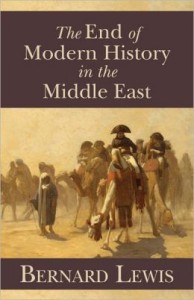|
Reviewed by Asaf Romirowsky, Ph.D. Candidate, Kings College London The eminent doyen of Middle East Studies Bernard Lewis who recently turned 95 has been writing history books since before World War II and, of late, has been serving as the chairman of the recently founded Association for the Study of the Middle East and Africa (ASMEA). Already by 1950, he was a leading authority on the Arab world, and after 9/11, the vice president and the Pentagon’s top brass summoned him to Washington for his guidance. Lewis has now written another revealing book about the Middle East of 2011 titled The End of Modern History in the Middle East. It is especially timely now on the heels of what has become known as the “Arab Spring” where mini-revolutions are taking place throughout the Arab world under the guise of change and reform. The question is what kind of change, and to what extent, will the people actually be able to reform any of these totalitarian regimes or in the process, make them worse off than they already are. The spirit of the Tunisian Jasmine Revolution or intifada, depending on who you ask, spread like wild fire throughout the Middle East from Tunis to Egypt to Syria. In all, the Islamists have proven to be the voice of the people, no less “moderation” and are represented by the Muslim Brotherhood, which are one of only two political institutions that would survive any of the existing regimes, the other are the militaries of these respective countries. In terms of methodology, what has been so unique and different in this latest wave of change within the Arab world is the utilization of the social media namely Twitter and Facebook as a mechanism to galvanize the sense of urgency and overarching spirit and demand for change. By doing so, one did not physically need to be on streets of Cairo, Syria or Tunisa but just go online to participate yet the people on the street are able to point to them as supporters of the cause. Without a doubt it is easier to be a supporter of a revolution in 2011 than it was in Iran of 1979 or Berlin of 1989. As such, Lewis rightfully devotes an entire chapter to propaganda in the Middle East and traces its historical roots within the Arab World. He illustrates the extent to which this type of propaganda has cascaded throughout Islam and Islamic history in an attempt to eradicate Judaism and Christianity from scriptures, as well as archeological artifacts, to manipulate history to the way Islam wants it to be written. As he explains, “the propagandist function of poetry in pre-Islamic Arabia is familiar to all students of Arabic literature. The traditional classification of the different types of poetry includes at least three that have an important element of propaganda, the fakhr or boas, in which the poet makes propaganda on behalf of himself and his tribe; the madih or panegyric, in which he promotes his ruler or patron; and the hija or satire, consisting of negative propaganda against hostile or rival groups or persons…the fakhr is a technique of battlefield propaganda designed to strengthen the morale of one’s own fighters while undermining that of the enemy.” Consequently, one of the unique aspects of the Arabic language is that most words have several different meanings and connotations. This allows a sophisticated leader or individual to manipulate the meaning in a way that suit his agenda. It is exactly how Nazis used their propaganda and how the Protocols of the Elders of Zion became a factual pamphlet. Understanding the above, is key to understanding the “Arab Spring” and the rise of Islamism throughout the region. Democracy, liberalism or reform do not actually mean what we in the West perceive them to be. All which allow Lewis to eloquently explains how this technique has served as a foundation for the “new” anti-Semitism focused on Zionism and Israel. “The new anti-Semitism has little or no bearing on the rights and wrongs of the Palestine conflict, but it must surely have some effect on perceptions of the problem and therefore on the behavior and perhaps even on the policies of both participants and outsiders,” he writes. In sum, all students and policy makers who truly want to understand the ever changing Middle East, especially today, should read this book. As in all his books Bernard Lewis is able to bring alive the culture and politics of the Middle East while unearthing the many cleavages that get lost in translation between the West and the East. |


 The End of Modern History in the Middle East
The End of Modern History in the Middle East